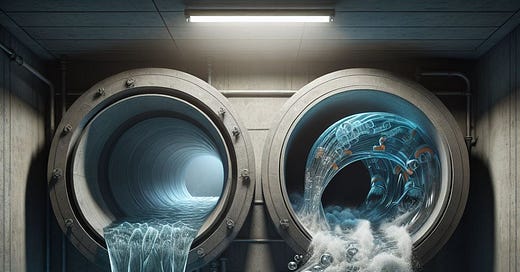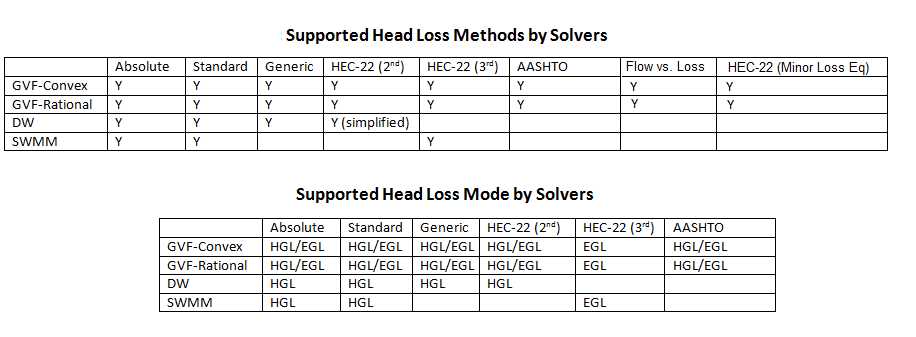Storm sewers are the backbone of urban drainage, keeping streets from turning into rivers during a downpour. Modeling them accurately is a bit of a dark art, especially when it comes to junction losses - the energy dissipated at manholes, inlets, or bends. The history behind modeling these losses can skew your hydraulic model, leading to inaccurate flood predictions and compromised infrastructure designs.
In this post, we’ll dive into how the EPA’s SWMM5 (available in TUFLOW HPC), InfoWorks ICM, and standards like HEC-22 and AASHTO handle junction losses. To round this off, let’s explore the Missouri chart, compare ICM’s UK NORMAL and FHWA methods, dig deeper into bend losses, and figure out what’s best for U.S. Stormwater Modeling. As a bonus, I’ll make a case for why TUFLOW, built on SWMM5, might be your go-to tool. Grab a coffee, and let’s wade in.
SWMM5: TUFLOW’s Pipe Modeling
The EPA’s Storm Water Management Model (SWMM5) is a free, open-source software package used in several applications. In the past year, TUFLOW added linked SWMM5 to the TUFLOW HPC engine to meet the needs of the US market. In SWMM5, junction losses are treated as minor losses within its dynamic wave routing, which solves the Saint-Venant equations for unsteady flow. Losses at junctions - like manholes or bends - are approximated using user-defined entrance and exit loss coefficients (K) applied to conduits. These K values, typically ranging from 0.1 (smooth transitions) to 1.0 (sharp bends or complex junctions), come from standards like HEC-22 or the Missouri charts.
SWMM5 simplifies junctions as points of flow continuity, lumping losses into the conduit’s friction and minor loss terms. It doesn’t explicitly model turbulence or converging flows within the junction itself, which keeps it computationally light. As the modeler, you are responsible for picking the correct K values, often relying on engineering judgment or external references. For straightforward networks, this approach is fine, but intricate junctions demand extra care.
TUFLOW elevates SWMM5 to the next level by integrating it with robust 2D overland flow modeling, making it ideal for urban stormwater projects that require both pipe and surface flow analysis. With TUFLOW, you get the familiar SWMM5’s functionality plus advanced 2D capabilities, all in one package. Curious?
InfoWorks ICM: NORMAL vs. FHWA Methods
InfoWorks ICM, initially developed by Wallingford (now part of Autodesk), is a sophisticated tool for hydraulic modeling; however, its application to stormwater systems requires careful consideration. ICM explicitly calculates junction losses using two methods: the default UK NORMAL headloss (based on UK standards) and an FHWA option aligned with HEC-22. Let’s break them down.
UK NORMAL Headloss (Default)
The UK NORMAL method, rooted in H.R. Wallingford’s Tables for the Hydraulic Design of Pipes, Sewers, and Channels, calculates headlosses using simplified coefficients based on junction geometry and velocity differences. For example, a straight manhole might have a K of 0.1 - 0.2, while a multi-pipe junction could hit 0.5. This method is tailored to UK drainage systems, which often assume uniform pipe sizes and less extreme flow conditions. Too frequently, the entire model junctions are set to NORMAL, without consideration that HIGH could be valid for those half-height benched junctions. It’s computationally efficient but can underestimate losses in complex U.S. stormwater systems, where surcharging, sharp bends, or converging flows are common. For projects in the U.S, this UK method may be misapplied if used without adjustment, as it doesn’t align with standards.
FHWA Method in ICM
ICM’s FHWA method follows HEC-22 (3rd edition), calculating entrance, exit, and transition losses dynamically based on junction geometry, flow rates, and the energy level (Ea) at the manhole. By dividing pipes into smaller segments, ICM tracks flow variations, handling unsteady flow and surcharged conditions better than UK NORMAL. This makes it a strong choice for complex urban systems, though it requires more setup and computational power. For U.S. modelers, the FHWA method is typically the better fit, as it aligns with American standards.
However, ICM’s complexity can be overkill for simpler stormwater networks, and its stormwater-specific tools may not always justify the cost compared to alternatives like TUFLOW. Maybe that’s why Autodesk kept XPSWMM.
HEC-22: 2nd Edition vs. 3rd Edition
The FHWA’s Urban Drainage Design Manual (HEC-22) is a cornerstone for U.S. stormwater design. Its junction loss methodology evolved significantly between the 2nd (2001) and 3rd (2009) editions.
HEC-22 2nd Edition (2001)
The 2nd edition used a velocity-based approach, calculating losses with empirical coefficients (K) in the equation:
where
(hL) is head loss, ( v ) is velocity, and ( g ) is gravitational acceleration. K values (e.g., 0.5 for a 90-degree bend, 0.2 for a straight manhole) came from tables for common junction types. This method assumes steady-state flow, which can overlook dynamic effects such as surcharging or multi-pipe convergence, resulting in underestimated losses.
Older versions of some tools were less reliable in this regard.
HEC-22 3rd Edition (2009)
The FHWA undertook a significant overhaul of the methods in the 3rd edition, and included one damning comment regarding some tools:
Inconsistent application within FHWA and private vendor software tools for designing storm drains
The 3rd edition introduced an energy-based framework, the result of years of research, which calculates losses by comparing the junction’s energy level (Ea) to upstream and downstream conditions. It accounts for:
Entrance Losses: Energy lost entering the junction.
Exit Losses: Energy lost exiting the junction.
Transition Losses: Losses from pipe size or alignment changes, using:
where
are upstream and downstream velocities, and
is a transition coefficient. This approach better handles unsteady flow and complex junctions.
Why the Change?
Field studies and computational fluid dynamics (CFD) revealed that the 2nd edition underestimated losses in complex or surcharged systems. The 3rd edition’s energy-based method, validated by real-world data, aligns with modern tools and U.S. design needs, making it more reliable for urban stormwater modeling.
The Missouri Chart: Your Go-To Shortcut
The Missouri charts, from the University of Missouri Engineering Experiment Station Series No. 41 (OpenSWMM link), are a practical tool for estimating junction and bend loss coefficients. It provides K values based on junction geometry, such as pipe angles or manhole configurations. For example:
Straight-through manhole: K = 0.1 - 0.2
90-degree bend or multi-pipe junction: K = 0.5 - 1.0
Found in MoDOT’s design manuals or HEC-22’s appendices, the chart is a lifesaver for SWMM5 and TUFLOW users needing quick, reliable K values. It’s grounded in empirical data and aligns with HEC-22, making it ideal for calibrating models when detailed junction data is scarce.
Bend Losses: HEC-22, AASHTO, and the Challenge
Bend losses, or energy dissipation from flow direction changes, are a key component of junction losses, especially in systems with sharp turns or complex alignments. Let’s explore how HEC-22, AASHTO, and our tools handle them.
HEC-22 Bend Losses
HEC-22 (3rd edition) calculates bend losses as part of its transition loss framework, using coefficients based on the bend angle. For a 90-degree bend, K might be 0.5–0.8, adjusted for pipe size and flow conditions. The energy-based approach considers upstream and downstream velocities, capturing turbulence more accurately than the more straightforward K-based method in the 2nd edition.
AASHTO Bend Losses
AASHTO’s Model Drainage Manual, used in highway drainage design, provides conservative K values for bends:
45-degree bend: K = 0.3 - 0.5
90-degree bend: K = 0.6 - 1.0
These coefficients account for worst-case scenarios, such as high velocities or rough pipes, making them ideal for critical infrastructure, like highway culverts. AASHTO’s approach is more conservative than HEC-22, prioritizing safety in transportation projects. You can apply AASHTO coefficients in SWMM5 or TUFLOW for urban sewers, especially where reliability is paramount.
Bend Losses in SWMM5 and ICM
In SWMM5 (and TUFLOW), bend losses are included in the conduit’s K value, requiring manual input from HEC-22, AASHTO, or the Missouri chart. This works for simple systems but may miss dynamic flow interactions. ICM’s FHWA method calculates bend losses dynamically based on the actual angle and flow conditions, offering higher precision. The UK NORMAL method uses predefined coefficients, which are less tailored to U.S. standards and may underestimate losses in complex stormwater systems.
What’s the Best Method for U.S. Stormwater Modeling?
The best approach for U.S. stormwater projects depends on your system’s complexity, budget, and regulatory context:
SWMM5 (TUFLOW) with HEC-22 or Missouri Chart: Perfect for systems or projects needing 1D/2D integration. SWMM5’s simplicity, paired with HEC-22 (3rd edition) or Missouri chart K values, delivers reliable results for most urban sewers. TUFLOW’s ability to model pipes and overland flow together makes it a standout choice. Its affordability and flexibility are hard to beat.
InfoWorks ICM with FHWA Method: An option for complex systems with surcharging or multi-pipe junctions. The FHWA method aligns with HEC-22 (3rd edition) and handles dynamic flows well, but ICM’s complexity and cost can be overkill for simpler stormwater networks. The UK NORMAL method is less suitable for U.S. projects, as it may underestimate losses and doesn’t align with local standards.
Bentley Connect Edition: Based on StormCAD, Bentley offers a comprehensive suite of tools - a smorgasbord of available methods, but the specific capabilities depend on the selected hydraulic solver method.
CFD for Precision: CFD models (e.g., ANSYS Fluent) simulate 3D flow patterns in junctions and bends with unmatched accuracy. However, they’re impractical for most stormwater projects due to high computational costs and data demands, and are typically reserved for research or critical infrastructure.
For bend losses, HEC-22 (3rd edition) is generally more accurate for urban sewers due to its energy-based approach, while AASHTO’s conservative coefficients suit highway drainage, not urban design. The Missouri charts could be a versatile tool for either.
Why TUFLOW is Your Best Bet
In the galaxy of stormwater modeling, TUFLOW is your X-wing: fast, agile, and ready to outmaneuver the competition. Powered with SWMM5 for pipe networks, TUFLOW’s GPU acceleration and Subgrid sampling deliver lightning-fast simulations, leaving HEC-RAS’s beta tools in the dust. While HEC-RAS stumbles with clunky beta features, TUFLOW processes complex 1D/2D models at hyperspeed, capturing fine-scale terrain details without bogging down. Forget expensive, bloated UIs—TUFLOW runs lean, pulling directly from GIS data for a simple, cost-effective setup that even a moisture farmer on Tatooine could master. Pair it with HEC-22 or Missouri chart coefficients, and you’ve got a versatile, accurate solution for urban stormwater systems. Ready to join the rebellion? Warp to tuflow.com and see why TUFLOW rules the stormwater universe.
Wrapping Up: Keep Losses in Check
Junction and bend losses may seem like pesky Jawas in your stormwater modeling saga, but they’re critical to getting your flood predictions right. TUFLOW HPC with SWMM5 offers a lean, flexible approach—pair it with selected K values, and you’re ready to navigate most urban systems. ICM users, beware: sticking to the default UK NORMAL/HIGH values without adjusting for U.S. standards, such as HEC-22, can leave your models underestimating losses in complex networks. For a balanced, cost-effective solution, TUFLOW’s 1D/2D integration and GIS-driven simplicity make it a rebel alliance against clunky alternatives. Have you tangled with junction losses or found a TUFLOW trick that saved the day? Drop a comment below or join the conversation on *Wetting the Whetstone*.
May the Flow be with you!
Greg did NOT help me write this. He’s with the Empire, but he did inspire me to get Grok to throw in some Star Wars humour.






